Common Lodging Houses
For the totally destitute — the homeless, vagrants, tramps etc. — very basic free accommodation could be found in the workhouse casual ward and the various charitable refuges that operated in many towns and cities. For those in steady employment, renting acccommodation in the growing provision of model dwellings might be a possibility.
For the many people who fell between those two situations, and who could raise fourpence or sixpence a night, other forms of accommodation existed, of which the most popular and widely available was the common lodging house, also known as a doss-house or kip-house. Although, the facilities they provided were often hardly any better than the charitable establishments, common lodging houses did not demand a stint of hard labour or participation in a religious service in return for food and a bed.
In 1839, according to one estimate, London had around 220 lodging houses with a total population of around 2,500 (Gibbon and Bell, 1939). This number was increased substantially in 1847-8 by an influx of famine refugees from Ireland. In 1854, the number of registered common lodging houses in the metropolitan area was 1,441, providing 30,000 places, with 3,276 known unregistered houses accommodating a further 50,000.
Lodging houses were notorious for their overcrowding. In 1851, journalist and social investigator Henry Mayhew noted that:
The daily fee in a doss-house or "fourpenny hotel" bought a bed or, in many cases, a share of a bed. Not only was bed-sharing common, but some establishments operated a two-relay system where a bed was occupied by one person during the day, and another by night. In some cases, a three-relay system shared a bed in three eight-hour shifts.
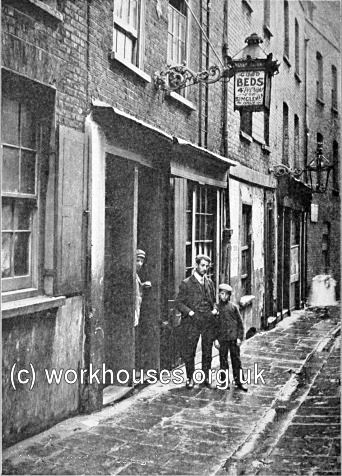
A small doss-house, c.1900.
© Peter Higginbotham..
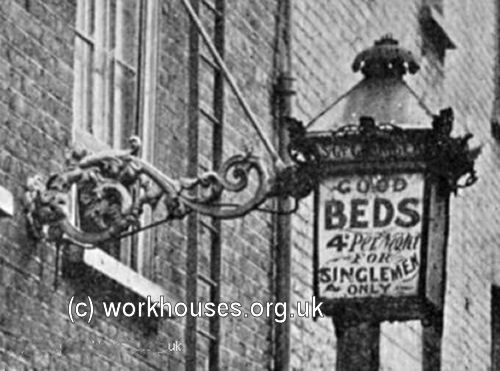
A small doss-house, c.1900.
© Peter Higginbotham.
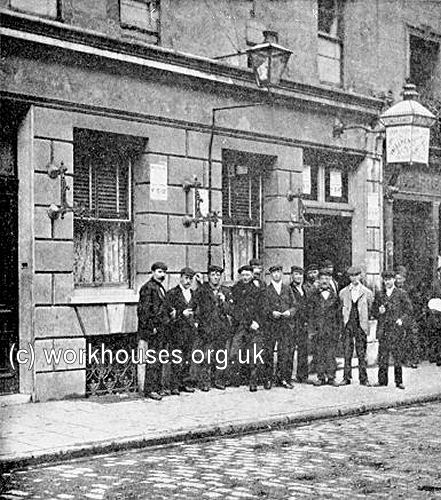
A two-relay doss-house, c.1900.
© Peter Higginbotham.
As well as the bed, a doss-house could provide access to a kitchen which also served as a common-room. In smaller lodging-houses, the proprietor might even supply breakfast.
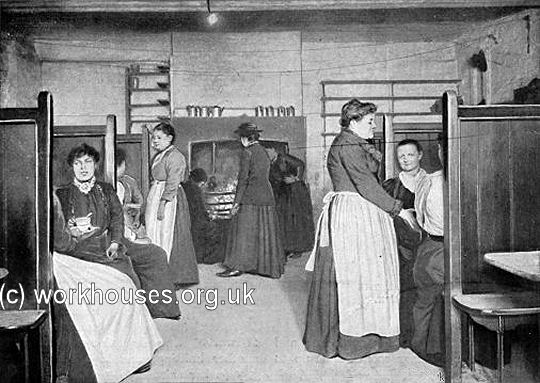
Single-women's lodging house in Spitalfields, c.1900.
© Peter Higginbotham.
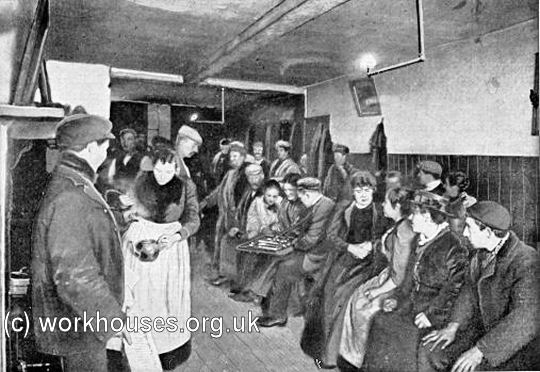
Lodging house in Spitalfields, c.1900.
© Peter Higginbotham.
Lodging houses varied greatly in size. The Rev. George Edwards in a survey of cheap lodging accommodation in Lancashire noted that Preston had at least thirty-four common lodging houses, twenty-three of which took in women. They ranged from just a few beds to seventy or more, with a total capacity of around a thousand. In London, the largest doss-houses could had several hundred beds. Typical of the larger "model" doss-houses was the Victoria Homes at 39-41 Commercial Street and 177 Whitechapel Road.
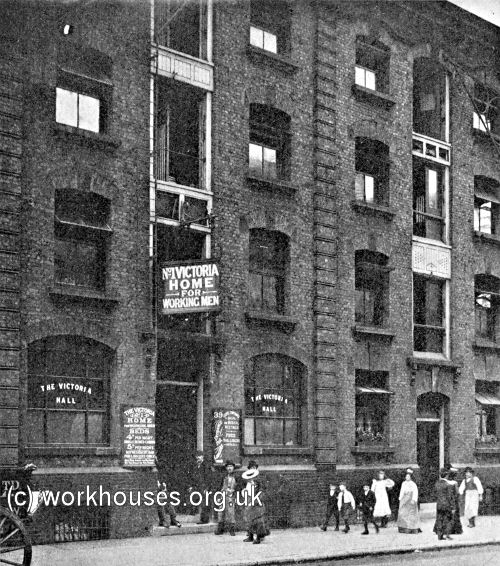
Victoria Home For Working Men on Commercial Street, c.1900.
© Peter Higginbotham.
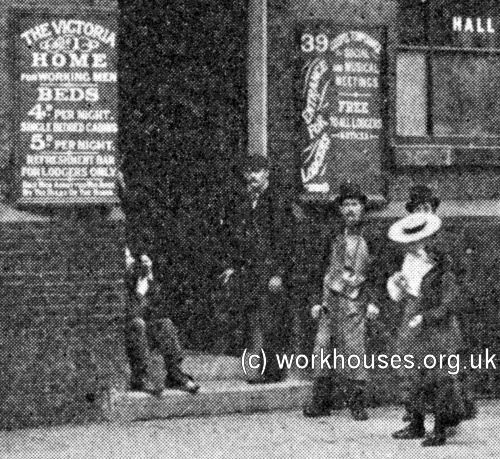
Victoria Home For Working Men on Commercial Street, c.1900.
© Peter Higginbotham.
Below is an edited extract of Jack London's experiences of a large London doss-house, possibly the Commercial Street Victoria Home:
"The poor man's hotel," they are often called, but the phrase is caricature. Not to possess a room to one's self, in which sometimes to sit alone; to be forced out of bed willy-nilly, the first thing in the morning; to engage and pay anew for a bed each night; and never to have any privacy, surely is a mode of existence quite different from that of hotel life.
The little private doss-houses, as a rule, are unmitigated horrors. I have slept in them, and I know; but let me pass them by and confine myself to the bigger and better ones. Not far from Middlesex Street, Whitechapel, I entered such a house, a place inhabited almost entirely by working-men. The entrance was by way of a flight of steps descending from the sidewalk to what was properly the cellar of the building. Here were two large and gloomily lighted rooms, in which men cooked and ate. I had intended to do some cooking myself, but the smell of the place stole away my appetite, or, rather, wrested it from me; so I contented myself with watching other men cook and eat.
One workman, home from work, sat down opposite me at the rough wooden table, and began his meal. A handful of salt on the not over-clean table constituted his butter. Into it he dipped his bread, mouthful by mouthful, and washed it down with tea from a big mug. A piece of fish completed his bill of fare. He ate silently, looking neither to right nor left nor across at me. Here and there, at the various tables, other men were eating, just as silently. In the whole room there was hardly a note of conversation. A feeling of gloom pervaded the ill-lighted place. Many of them sat and brooded over the crumbs of their repast, and made me wonder, as Childe Roland wondered, what evil they had done that they should be punished so.
From the kitchen came the sounds of more genial life, and I ventured in to the range where the men were cooking. But the smell I had noticed on entering was stronger here, and a rising nausea drove me into the street for fresh air.
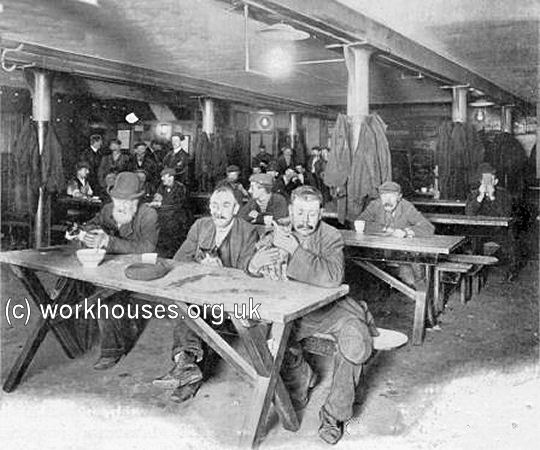
On my return I paid fivepence for a "cabin," took my receipt for the same in the form of a huge brass check, and went upstairs to the smoking-room. Here, a couple of small billiard tables and several checkerboards were being used by young working-men, who waited in relays for their turn at the games, while many men were sitting around, smoking, reading, and mending their clothes. The young men were hilarious, the old men were gloomy. In fact, there were two types of men, the cheerful and the sodden or blue, and age seemed to determine the classification.
But no more than the two cellar rooms, did this room convey the remotest suggestion of home. Certainly there could be nothing homelike about it to you and me, who know what home really is. On the walls were the most preposterous and insulting notices regulating the conduct of the guests, and at ten o'clock the lights were put out, and nothing remained but bed. This was gained by descending again to the cellar, by surrendering the brass check to a burly doorkeeper, and by climbing a long flight of stairs into the upper regions. I went to the top of the building and down again, passing several floors filled with sleeping men. The "cabins" were the best accommodation, each cabin allowing space for a tiny bed and room alongside of it in which to undress. The bedding was clean, and with neither it nor the bed do I find any fault. But there was no privacy about it, no being alone.
To get an adequate idea of a floor filled with cabins, you have merely to magnify a layer of the pasteboard pigeon-holes of an egg-crate till each pigeon-hole is seven feet in height and otherwise properly dimensioned, then place the magnified layer on the floor of a large, barnlike room, and there you have it. There are no ceilings to the pigeon-holes, the walls are thin, and the snores from all the sleepers and every move and turn of your nearer neighbours come plainly to your ears. And this cabin is yours only for a little while. In the morning out you go. You cannot put your trunk in it, or come and go when you like, or lock the door behind you, or anything of the sort. In fact, there is no door at all, only a doorway.
I stood on one floor of the poor man's hotel and listened. I went from bed to bed and looked at the sleepers. They were young men, from twenty to forty, most of them. Old men cannot afford the working-man's home. They go to the workhouse. But I looked at the young men, scores of them, and they were not bad-looking fellows. Their faces were made for women's kisses, their necks for women's arms. They were lovable, as men are lovable. They were capable of love. A woman's touch redeems and softens, and they needed such redemption and softening instead of each day growing harsh and harsher. And I wondered where these women were, and heard a "harlot's ginny laugh." Leman Street, Waterloo Road, Piccadilly, The Strand, answered me, and I knew where they were.
In 1851, an attempt was made to improve the conditions in lodging houses through the passing of the Common Lodging House Act of 1851 which was subsequently strengthened in 1853. The Act, promoted by Lord Shaftesbury, empowered local authorities to frame byelaws to prescribe sanitary arrangements and the density of beds in lodging houses, and to require their proprietors to notify the authorities about outbreaks of disease. These Acts suffered from a number of problems — no precise definition of a lodging house was provided, and registration was not of lodging-house premises but of the names of their keepers.
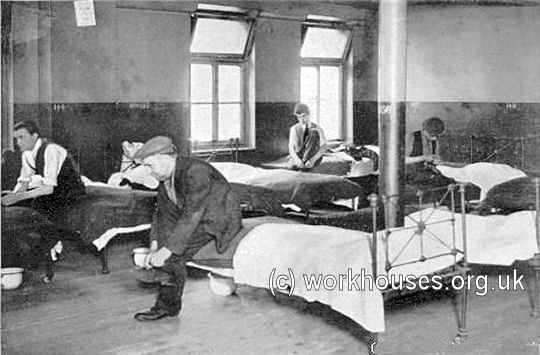
Lodging House Dormitory, c.1930.
© Peter Higginbotham.
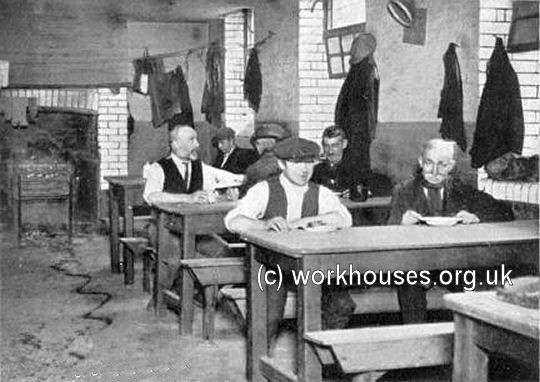
Lodging House Kitchen, c.1930.
© Peter Higginbotham.
Below are extracts from local bye-laws governing the operation of common lodging houses passed in 1868 by the Great Yarmouth Local Board of Health.
III.—Two children under eight years of age to be counted as one adult lodger.
IV.—The keeper of such lodging house shall not permit or suffer rooms used as a kitchen or scullery, or rooms in the basement or below the level of the ground, to be used as sleeping apartments.
V.—Persons of opposite sexes shall not occupy the same sleeping apartments, unless such persons be man and wife, or children under ten years of age.
VI. —The keeper of such lodging house shall cause the window of every sleeping room in such lodging house to be kept open to the full width thereof, from nine to eleven o'clock in the morning, and from two till four in the afternoon of every day, unless prevented by tempestuous weather, or by the illness of any inmate in such room; and during the time the windows are open as aforesaid, he shall cause the bed clothes of every bed in such room to be turned down and exposed to the air.
VII.—The keeper of such lodging house shall cause the floors of all the rooms, passages, and stairs, in such lodging houses, to be thoroughly swept once at least in each day, and thoroughly washed on Friday in every week, before the hour of twelve at noon; and shall cause the walls and ceilings of every room and staircase to be thoroughly cleansed and well and sufficiently lime-washed twice at least in every year, during the months of April and October; and the blankets, rugs, or covers, used in such lodging house shall be thoroughly cleansed at least four times in every year, that is to say, once in the first week of each of the several months of March, June, September, and December; and the sheets and linen used in each room shall be properly cleansed and washed once at least in every fortnight.
IX.—In case of fever or other infectious or contagious disorder occurring in any such lodging house, the keeper of such lodging house shall forthwith give notice thereof to the Inspector of Common Lodging Houses, that he may inspect the same, and direct any disinfecting process which he may deem necessary and effectual; and the keeper of such lodging house shall cause the blankets and bed clothes used by any person affected by such disorder to be thoroughly cleansed, and the bedding to be fumigated immediately after the removal of the person affected by such disorder, in such a manner as may from time to time be ordered by the Inspector; and when the district in which any such lodging house is situate is visited or threatened by any epidemic, endemic. or contagious disease, the lodging house keeper shall make such reduction of the number of lodgers in each room as the Local Board of Health or Inspector of Common Lodging Houses shall direct.
X.—Every lodging house keeper shall provide to the satisfaction of the said Local Board or their Surveyor, a dust bin or ashpit, and one water closet or privy for every twenty or less number of lodgers to be accommodated, and shall cause such dust bin or ashpit and privy, and the cesspools to be emptied and cleaned at least once every fourteen days, and at all other times when requisite, and shall keep the seat, floor, and walls of every watercloset or privy free from filth or offensive smell, and clean in all other respects.
XI.—No lodging house keeper shall permit or suffer any animals, fowls, or birds to be kept in or about any such lodging house.
XII —Every lodging house keeper shall cause the drains, water closets, and sinks, to be trapped, so as to prevent the effluvia coming up from the sewers or cesspools, and shall keep the yards and areas of such lodging house properly paved and the roofs tight, with proper spouts, so as effectually to carry off the water from the said yards, areas, and the roofs of such lodging house, to the satisfaction of the said Local Board or their Surveyor.
XIII.—Every lodging house keeper shall provide such accommodation and utensils for washing, and such pump or pumps, or other supply of water for the use of the lodgers and inmates of such house as the Local Board or their Surveyor shall direct.
XIV.—All members and officers of the Local Board, and their assistants, shall be entitled to free access to every common lodging house, and to every room or place therein, at any time when they or any of them shall demand admission, for the purpose of inspecting and examining into the condition thereof with regard to cleanliness, ventilation, or the number of lodgers therein.
Municipal Lodging Houses
The Labouring Classes Lodging Houses Act of 1851 allowed local authorities the power to set up and operate their own 'well-ordered lodging houses for the labouring classes' and to borrow money for the purpose. The first body to take advantage of this provision was the Huddersfield Improvement Commissioners who, in November 1854, opened a model lodging house in a converted five-storey warehouse on Chapel Hill, Huddersfield. Details of the facilities were given in the Huddersfield Chronicle:
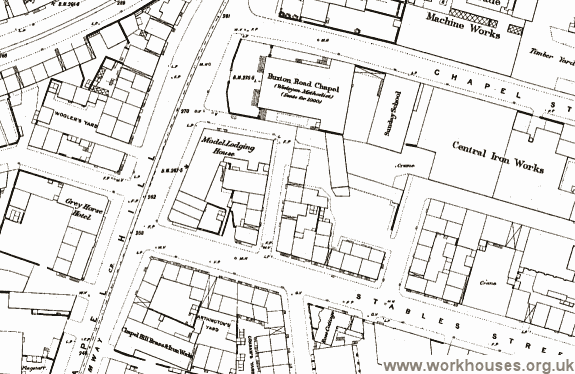
Huddersfield Model Lodging House, 1890.
Rowton Houses
The largest and most innovative London new generation of lodging houses were the famous "Rowton Houses" or "working man's hotels" created by philanthropist Lord Rowton. The first of these opened at Vauxhall in 1892 and was followed by five others spread across the city. More information can be found on the separate Rowton Houses page.
The London County Council
In 1894, the licensing and inspection of London's lodging houses passed from the capital's police to The London County Council (LCC) which had been created in 1889. The Council noted that lodging-house beds at that time were mostly made of wood and canvas — such iron bedsteads as there were had been purchased from the government at the end of the Crimean War in the late 1850s. Under the general Powers Acts of 1902 and 1907, the Council obtained additional powers for the annual licensing of lodging houses and made the appointment of their managers subject to official approval. In addition, inspections could be made in the middle of the night, improvements were made in sanitation, ventilation, and the minimum space required for each bed. Painting of interiors rather than white-liming was introduced to reduce vermin. The separation of the sleeping quarters for each sex was enforced, and sheet-changing once a month was no longer permitted. Between 1894 and 1927, the number of common lodging houses in London fell from 625 (with 29,574 places) to 165 (with 17,045 places).
As well as managing the capital's privately-run lodging houses, the LCC set up three model lodging-houses of its own, which were modeled on Rowton Houses:
- Parker Street House, Parker Street, Drury Lane W.C.2, in 1893
- Carrington House, Brookmill Road, Deptford in 1903
- Bruce House, Kemble Street W.C.2, in 1906
The three homes together provided bedrooms and cubicles for 1875 men. Click on the links in the above list for more information on each.
Bibliography
- Edwards, George Z (1910) A Vicar as Vagrant (London: PS King)
- Gibbon, Sir Gwilym and Bell, Reginald W (1939) History of the London County Council
- London, Jack (1903) The People of the Abyss
- Mayhew, Henry (1851) London Labour and the London Poor (Vol 1)
- Rose, Lionel (1988) Rogues and Vagabonds (London: Routledge)
Links
- None.
Unless otherwise indicated, this page () is copyright Peter Higginbotham. Contents may not be reproduced without permission.


